The Mystic Cobra, the hundred dollar bill, and the Secret Service
Picture an ordinary bodyshop paint booth: brightly lit, bare-walled, nearly spotless. The painter steps up, air-powered paint gun in hand, and aims the nozzle carefully at a masked-off part of a mid-’90s Ford Mustang. If there is a weird part to this fairly typical process, it’s the observer—an agent from the U.S. Secret Service, watching the repair work with an eagle eye.
The reason he is there is loaded in that paint gun. Instead of ordinary paint, it’s a shade called Mystic, technically colorless but capable of making light dance along a surface. In this application, the paintwork will return one of just 2000 Ford Mustang Cobra coupes to its former glory, a shade that seems purple, but shimmers to the eye. It’s the other application for Mystic that has the Secret Service standing by; the same paint going on that Mustang was used to print the U.S. $100 bill.
Baden Aniline and Soda Factory—better-known as BASF—acquired a smaller company called Flex Systems in the early 1990s. BASF was interested in creating holographic inks specifically for the production of currency, and Flex had expertise in the field. Specifically, it had come up with a technology for suspending tiny prisms in liquid paint, which would align as the paint dried and split light along the visible spectrum. The paint tech was patented as Prism Platelets.
You probably remember how a prism functions from your high school science textbook or the cover of Pink Floyd’s Dark Side of the Moon. Visible light, which appears white to the human eye, hits the angle of a glass (or other transparent material) prism and is slowed down and split into various wavelengths. The shorter the wavelength, the deeper the color, right down to indigos and purples.
Flex’s genius was in figuring out a way to turn paint into prisms by suspending tiny platelets in the liquid. When wet, the fluid didn’t look particularly special. When applied to a flat surface, like a banknote, the prisms lined up flat, overlapping each other. Slide a note printed with this ink under a light, and it had a holographic effect that was difficult to reproduce. Tough luck, would-be counterfeiters.
The Treasury department was looking to redesign the $100 bill in order to make it harder to fake, and Flex’s “prism platelets” were just the kind of cutting edge security tech to do it. A deal was struck, and BASF supplied the ink to the U.S. Treasury’s printers.
This special ink didn’t have any innate color itself, as it was the light-splitting that created the hues. However, adding in toners to the batch let the mixer change what the paint looked like when light hit it. It also varied depending on what kind of surface you sprayed it on. BASF started thinking about cars.
Color-shifting paint was not a new idea in 1995. Customizers had been experimenting with metallic flake in paint, from the SoCal Kustom Kar scene to wild-looking drag racers.
However, BASF’s pitch to Ford was the prospect of building the first production car to feature color-shifting paint. The BASF sales team carefully explained how the process worked. Ford wanted to see it on a car first. Two 1995 Mustang GT convertibles were sent to BASF for test-painting—the first two Mystic Fords.
But those were internal projects. As far as the public was concerned, the first Mystic Mustang wasn’t a Ford, but a Saleen. The long-time customizer brought a Mystic-painted S351R Speedster to SEMA in 1995, and the car got plenty of attention. Seeing the positive feedback, Ford decided to move ahead on production.
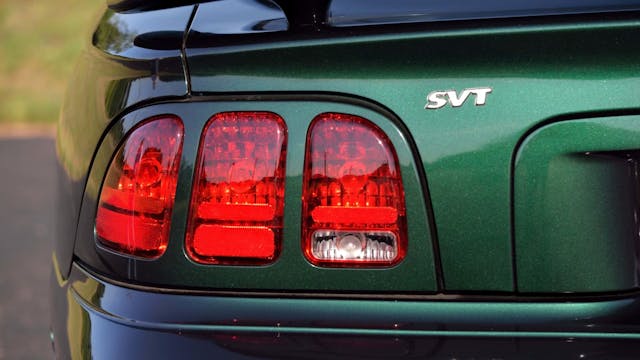
Originally, only 1999 customer cars were to receive the Mystic treatment, all of them 1996 Mustang Cobra coupes. However, an additional 1996 coupe was painted first for PR duties, and it somehow later made its way into private hands.
All of the Cobras started out life painted black. Ford shut down the Dearborn production line, so all of them could be painted at once. The paint process itself wasn’t unusual, just a base coat, the Mystic layer, and then a clear coat over top. The paint code for Mystic was designated LF, and the price for the option was $1152. Almost all the cars came with black leather interiors, and all had the then-new handbuilt 4.6-liter V-8 good for 305 hp.
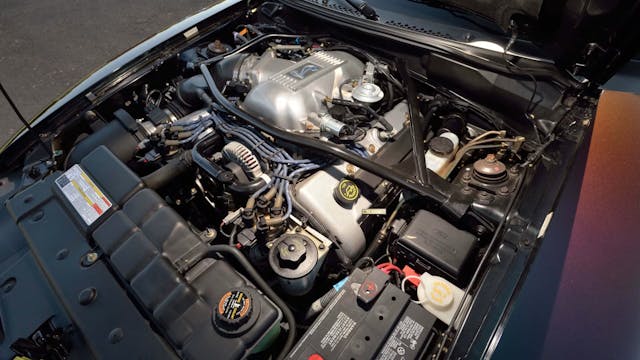
As it was blended with toners, it’s not like you could just load liquid Mystic into your inkjet printer and print off a hefty stack of Benjamins. However, careful filtering of the paint would yield those prism platelets, which could be added to ink and used to create nearly undetectable forgeries. Ford paint code LF would have to be a tightly regulated substance. You have to imagine the Feds blew a gasket when BASF told them Ford was painting entire cars with its counterfeit-proof ink.
However, Mystic was at least a limited edition, so there were only 2000 cars out there. Even better, used Mystic is useless to a would-be counterfeiter, as the prisms are unrecoverable when dried. It was only the liquid paint that needed to be carefully monitored. But then the next problem reared its head, one that would be familiar to anyone who has watched a montage of Mustangs leaving Cars & Coffee events.
Unless they’re mothballed in a collection, Cobras get crashed, or they get crashed into. That means a bodyshop has to get involved, and you can’t just send a gallon of anti-counterfeit ink to to Al’s Fender-Bender Hospital and hope that none of it walks off the premises. No offense, Al.
The solution was to first check the VIN of any car being repaired to ensure it was actually a Mystic Cobra, and then to dispatch a supervisor. The supervisor could be a trusted Ford or BASF employee, but often Treasury and Secret Service agents were also sent into the field. They’d guard the paint, even helping with post-paint cleanup to ensure every drop of Mystic was accounted for.
Repairing a Mystic Cobra was doubtless one of the more stressful jobs a paint booth tech would get. Thankfully, repairs were rare, as Ford only did that one single run of Cobras with Mystic paint.
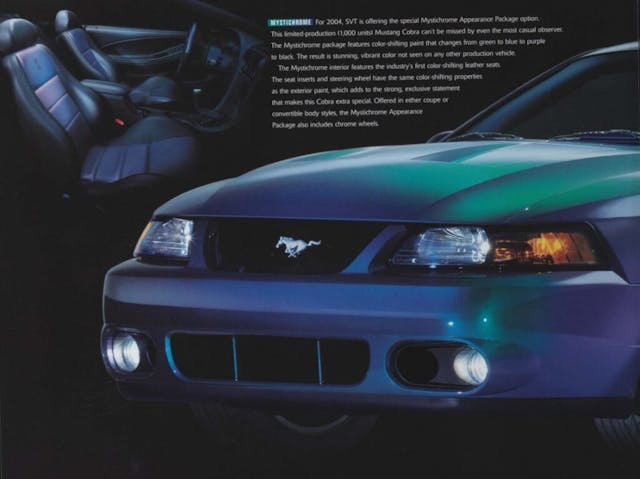
Later, however, the similar Mystichrome paint came along. Available on the supercharged 2004 SVT Cobra (code-named Terminator), this shade celebrated the Mustang’s 40th anniversary and extended to some interior parts. The paint code was now different from Mystic, and the paint didn’t need to be so highly supervised. Any bodyshop with the proper PPG Platinum certification can repair a Mystichrome Cobra. However, it’s still a stressful job, as the paint costs an eye-watering $26,600 per gallon.
In 2020, a tech entrepreneur named Justin Choi paid $100,000 to have his Ford GT painted in Mystichrome. It was a one-off, with Ford promising that no other GT would receive the treatment. It’s a pretty special car, and Choi sees the paint choice as a tribute to his uncle, who sold Fords in the Los Angeles area and was forever bringing home Blue Oval hats and jackets for his nephew.
But for the rest of us, the door is still perhaps open for a color-shifting paint treatment for some future Mustang model. It is, after all, coming up on 20 years since the Mystichrome Cobra, and both it and the original Mystic Cobra are still desirable collector items.
If you have one of these rare machines for sale, it’ll be sure to fetch many, many banknotes with Benjamin Franklin’s face on them. But if the buyer idly mentions working in a paint booth, make sure you check those notes carefully before handing over the keys.
***
Check out the Hagerty Media homepage so you don’t miss a single story, or better yet, bookmark it. To get our best stories delivered right to your inbox, subscribe to our newsletters.
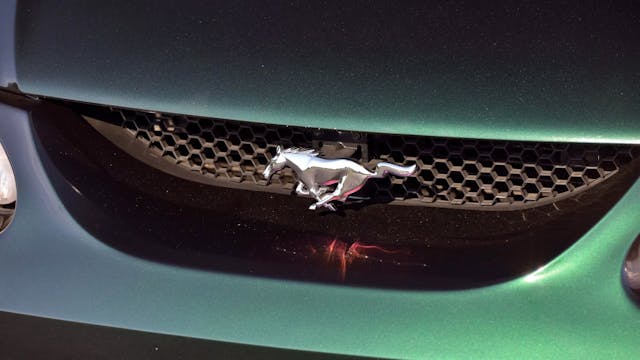
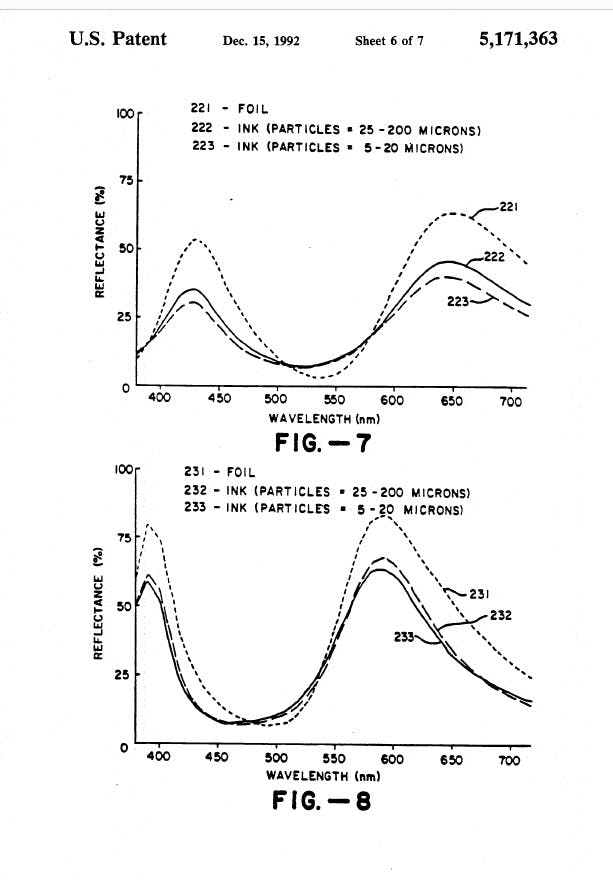


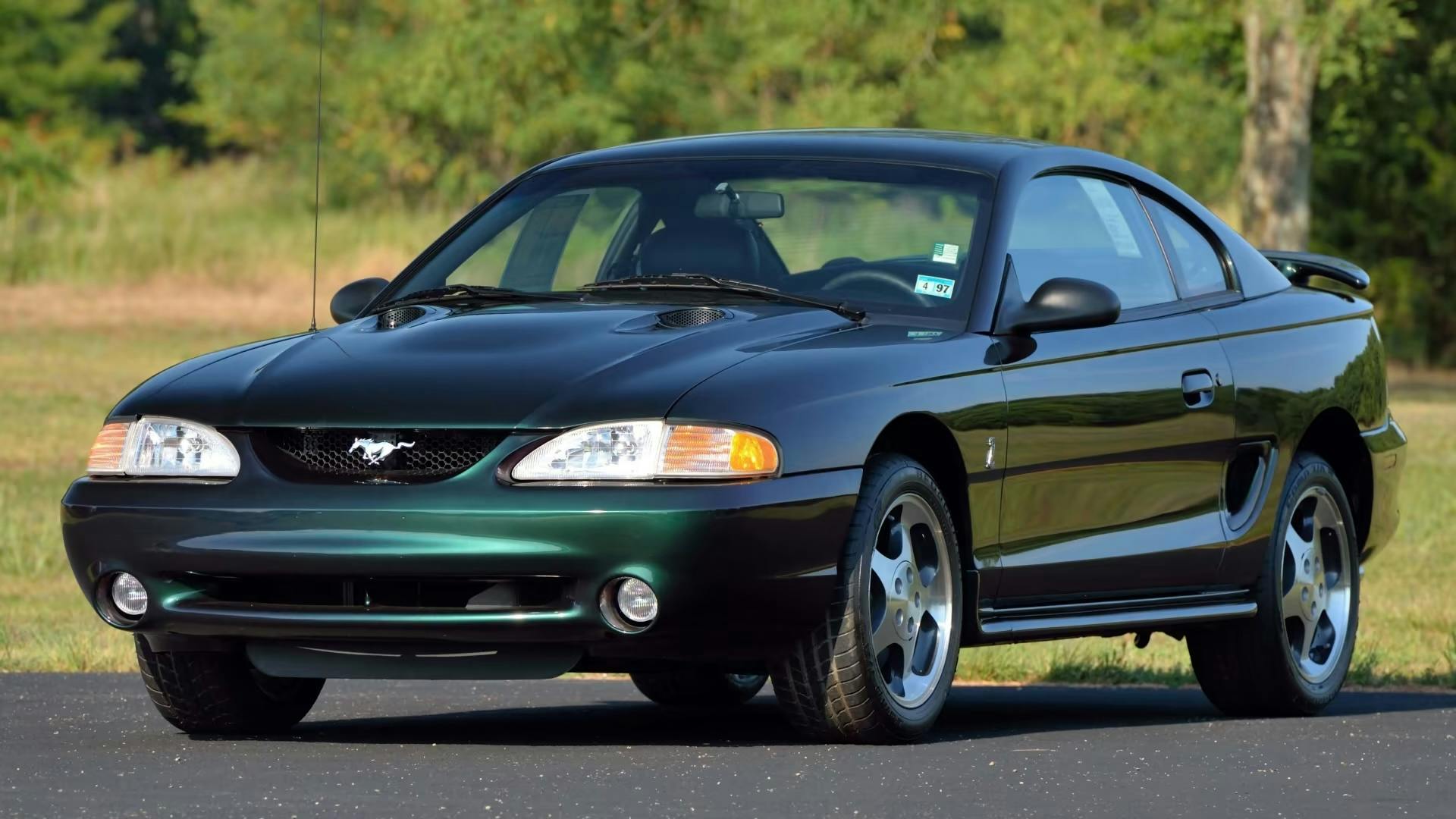
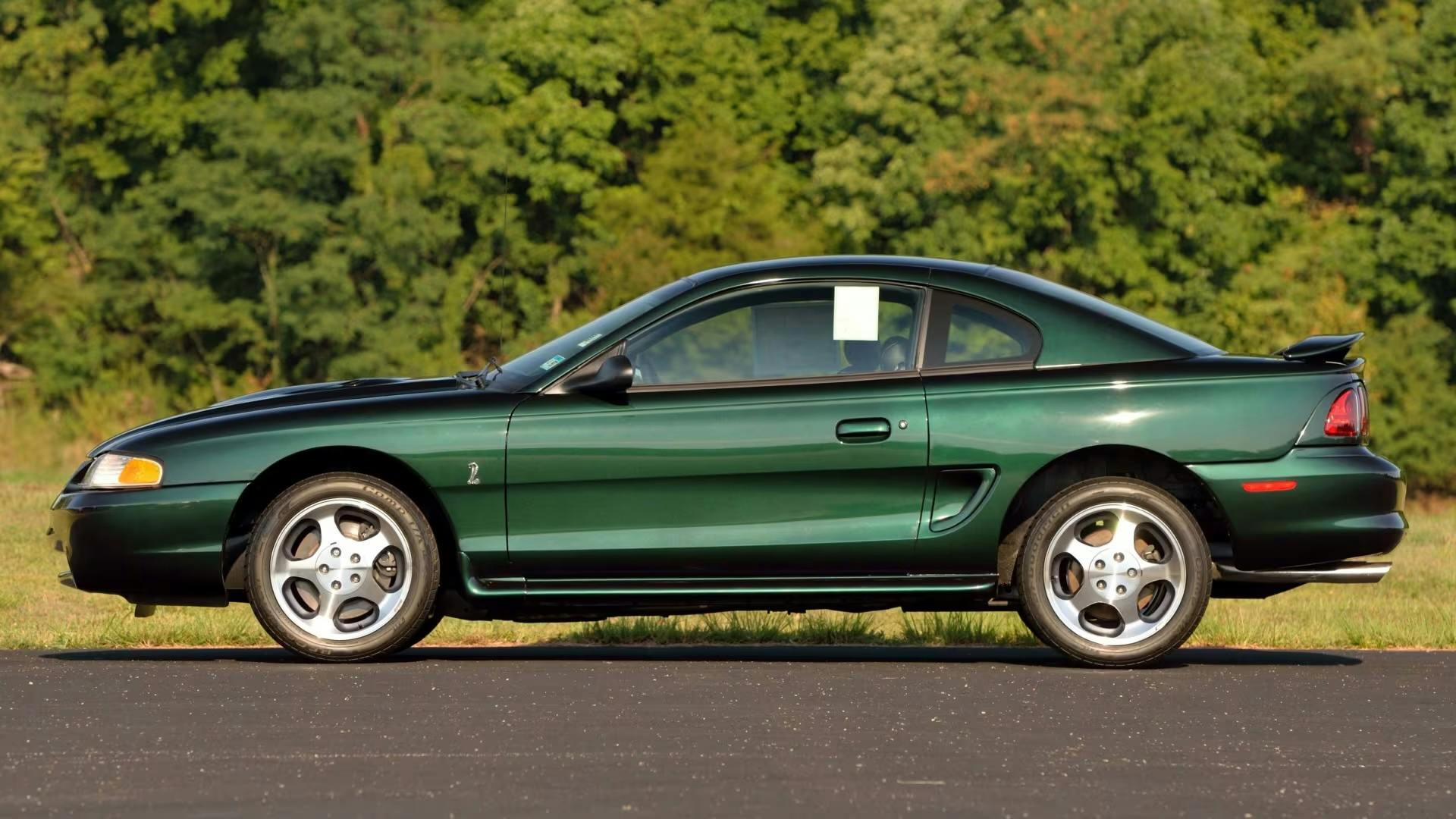


I’m pretty sure the bloom is off that rose. The color shifting paint was not real pretty and now it’s a thing of the past, like the pastel colors on the 80’s and early 90’s. The color shifting colors just weren’t good colors, for most people.
Pastel colors are not a thing of the past. The modern-day Cavalry Blue paint on select Toyota vehicles is a pastel color that looks great.
Very interesting story!
Is BASF the same company noted for its magnetic audio tapes?
I believe you got the wavelength thing backwards — Violet & Ultraviolet are the shorter wavelengths, whereas Red & Infrared are much longer.
(Sajeev; when are you folks going to start paying me for proofreading?)
I believe you are right and we shall address this. Unfortunately I like everyone here at Hagerty Media, otherwise allocating funds to you would be a fantastic investment. 🙂
We had one of the 1996 Mystic Cobras for several years. We loved the paint on it. When my wife first saw the car, she kept walking around it, getting the different color shifts as she went. She was alway frustrated whenever we took a picture, and the angle of the light was not right to get the purple color shift that she liked the best.
When I read the title to this one: “The Mystic Cobra, the hundred dollar bill, and the Secret Service”, I had no clue how the Secret Service was going to fit into the story, but I just knew that this would be about the story all us hotrodders have heard (and many of us experienced). You know: the driver tapes a hundred dollar bill to the dash and says “You can have it if you can reach it while I’m on it.” I will admit that I was that passenger once, and no – I couldn’t reach it. (’71 Heavy Chevy Chevelle) Was really looking forward to reading of someone’s similar experience in a Cobra. Oh well…
Years ago, a friend of mine had a GT-1 Corvette and had it painted this color. I remember him saying that it was a very expensive paint job. Depending how the light hit it the color would change. Since then I have never seen another one like it.
This has to be one of the most fascinating car stories I’ve ever read! I had no idea about the relationship between the Cobra paint and our currency, but this is a great story to be able to retell to car and non-car friends alike.
I bought a 2011 Lexus ES350 with a metallic paint that changes color from dark blue to black to purple, depending on the light. The color was available for only one year. Am wondering if there is any more information about this particular paint product out there and if it’s story is related to the Mustang story here.
That’s just a metallic paint called monocromatic paint that changes color depending on the angle of the light hitting the fakes. What they are talking about is a hologram that creates a prism similar to the rainbow color in oil but more controlled. One paint uses metal flakes for that color change the money paint uses a proprietary chemical makeup with a catalyst to create holographic prisms usually in a clear coat finish that’s transparent from one angle and holographic rainbow from another. Example is your passport photo page take a flashlight to it and move it around and you’ll be able to see the difference between metallic and a transparent holographic finish that’s pretty durable especially able to flex w/o cracking. If I were to guess it’s probably some sort of oil mixture with some other chemicals that’s able to be added to a clear coat that catalyzed and sprayed and might even have to be layered in a particular way to get the desired effect.
There was a guy with a Mystic painted Cobra in my area. I love the greens and purples it produces.
Interesting back story on a paint that had limited appeal to most car buyers, but apparently a lot of appeal to currency counterfeiters!
Isn’t that paint similar to the Camellion(SP) paint from the early 2000’s?
I had a 2007 Chevy Avalanche that was “Midnight Blue Metallic” and was blue in most light and green in some. Loved it and hated to let the truck go. I believe it was a one year only color.
When I was a child in the sixties my parents had a car that I think was painted blue-ish. At night under the street lights it looked purple. I was probably about 5-7 years old so I don’t recall what make or model car. Could have been a fifties car because my parents couldn’t afford new vehicles with 4 rugrats. Just something that stuck with me all the years
Funny you brought this up as I also remember seeing that with some cars parked along the street in front of downtown businesses. I think those cars were lighter colors. Street lights of the era were mercury vapor which produced a great deal of ultraviolet light may have been the reason.
I own one of the two 1995 Mustang GT convertibles that was first painted.
The cars were not all painted at once. That’s an internet myth. They were painted as ordered. Info straight from the Rouge paint shop manager. A separate paint tank was set up outside the paint line. Outside meaning outside. A long piping system was built and kept at a constant temp. And when a Mystic came down the line they painted it. Wing and front bumper were painted by hand off the cars. For 1996 the Mystic Cobra was the premier Mustang and a future collector car.
Reason for painting the bumpers and wing separate was because a flex agent needs to be added when painting anything other than metal so the paint doesn’t crack when the plastic flex’s.
I had a color-shifting ’96 Dodge Avenger two-door in prism blue, which shifted between blue and purple. It was great. With the 2.0 and a manual transmission I’d routinely break 40 mpg. It averaged over 36 for the entire life of the vehicle.
Carrol, really screwed up, when he sold the Cobra name to Ford, for $1.00!
No he didn’t ! Carol Shelby had a great career and loved what he did. Ford took care of him very well or he would have never spent so much of his career with them. Plus Ford always gave free range to Carol and he had all of Ford’s engineers at his disposal. Ford also created one of the greatest motors for Carol the Ford 427 side oiler which was a monster and was able to handle twin superchargers which he had put in his ac cobra just to beat his buddy’s Ferrari. Just imagine having all of Ford at your disposal to do just about anything you want is absolutely amazing and he showed his gratitude by giving Ford the Cobra brand. The $1 was only a formality. Carol Shelby was worth $40 million when he passed away in 2012. That’s not a bad career at all and he’ll be remembered forever and the Cobra brand will continue for years and years to come because Ford announced they have no plans to stop making the V8 Mustangs which will always include the Cobra’s